
Plutonium and the End of Humanity
Truther
Fukushima radiation has traveled the globe. Much of the fallout follows the atmospheric jet stream and has blanketed Alaska, Canada, the U.S. Pacific northwest, U.S. west coast and U.S. mid-west. However, radioactive contamination from Fukushima has also been detected in Europe and even in the southern hemisphere. A fallout map, based only on one of the six reactors melting down, shows the widespread deposition of nuclear particles across a huge geographic region.
(SCROLL DOWN)
*
*
*
*
*
*
*
*
*
*
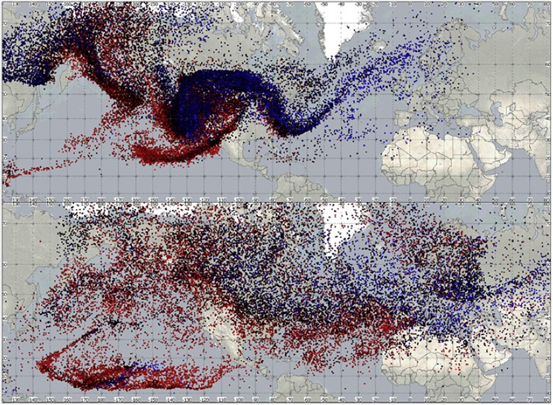
Think again, think seven times again before you leap
and start construction of new nuclear power plants.
June 2006
Chronological Graphs on Concentration in the Air [aCi/m3]
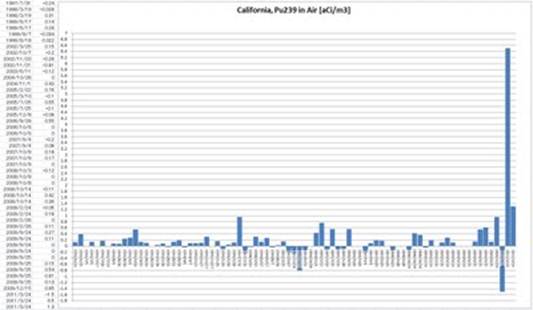
Plutonium 239 in California (past 20 years)
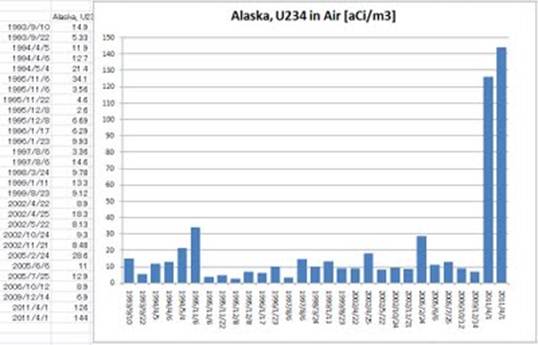
Uranium 234 in Alaska (past 20 years)
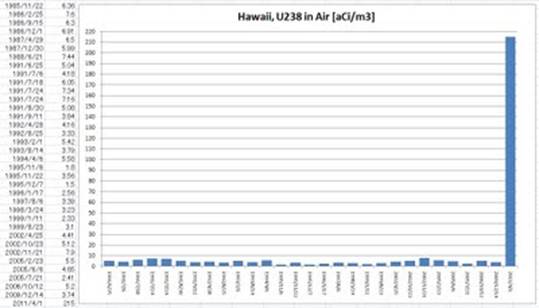
Uranium 238 in Hawaii (past 20 years)
Such sudden increase of radioactive materials, as indicated in the above graphs, are a direct result of Fukushima. These regions where increased amount of plutonium and uranium were detected are downwind of Japan. The closest places are Guam, Hawaii, Alaska and California. If you compare the numbers after March 11 between California (8700 km = 5400 miles from Japan) and Guam (2500 km = 1550 miles from Japan), Guam has detected 78 times higher plutonium 239, 6 times higher uranium 234, 16 times higher uranium 235 and 13 times higher uranium 238 than California.
Radiation fallout patterns have long taught us that the closer one is to the source of contamination the higher the radiation exposure. Heavy nuclear particles fall to the ground quite quickly thus thinning quickly as the distances open up. Being downwind of an atomic explosion or nuclear meltdown is not healthy, for people in close proximity will absorb that many more radioactive particles from the air, water and food.
It is only getting worse
TEPCO, the operator of Japan’s crippled Fukushima nuclear plant, said Wednesday record amounts of radiation had been detected in the basement of reactor number 1, further hampering clean-up operations. TEPCO took samples from the basement after lowering a camera and surveying instruments through a drain hole in the basement ceiling. Radiation levels above radioactive water in the basement reached up to 10,300 millisievert an hour, a dose that will kill humans within a short time after making them sick within minutes. The annual allowed dose for workers at the stricken site is reached in only 20 seconds. “Workers cannot enter the site and we must use robots for the demolition,” said TEPCO. The Fukushima operator said that radiation levels were 10 times higher than those recorded at the plant’s two other crippled reactors, number two and three. This was due to the poor state of the nuclear fuel in the reactor compared to that in the two others.
Radioactive material released from Fukushima was detectable all across the northern hemisphere 12-15 days after the accident. An official monitoring station in Iceland detected radioactive isotopes indicating that the plume had reached Europe on March 20. But now we hear from Chris Busby, who says he is monitoring, that no radiation has reached England where he is. Is this possible? (A client of mine had personal communications with him. This information needs to be verified.)
For the first four weeks, the radioactive materials remained confined to the northern hemisphere but by April 13 radioactive isotopes were detected at stations located in Australia, Fiji, Malaysia and Papua New Guinea indicating that it had reached the southern hemisphere.
Within two weeks the whole northern atmosphere was affected. The radioactive plume next travelled to eastern Russia (March 14) and then crossed the Pacific towards the North American continent to Europe and to Central Asia. The dominant radionuclides were xenon isotopes and especially Xe-133 together with I-131, Cs-134, and Cs-137, and further short-lived radionuclides like Te-132 and I-132 were also detected. Sadly, plutonium has been detected indicating early on the meltdown of spent-fuel assemblies.
According to the Nuclear Information Resource Center (NIRS), this plutonium-uranium fuel mixture is far more dangerous than typical enriched uranium—a single milligram (mg) of MOX is as deadly as 2,000,000 mg of normal enriched uranium. On March 14, Unit 3 of the Fukushima reactor exploded, sending a huge smoke plume into the air. This particular reactor, of course, contains the rods fueled with MOX.
International nuclear experts are criticizing efforts by the Japanese nuclear industry to stockpile surplus plutonium for use in reactors using MOX (mixed-oxide) fuel, a combination of plutonium and uranium. The MOX plan was a key component of the Japanese nuclear cycle and was supposed to allow reuse of spent fuel, resulting in a self-contained cycle. However, reprocessing has turned out to be more expensive than simply disposing of spent fuel by burying it, and the process itself has encountered numerous technical difficulties and public opposition.
Japan currently has 35 tons of plutonium stored worldwide, and hopes to produce another half-ton within the next nine months, raising global concerns that terrorists might obtain some of it and produce nuclear bombs. This is all pure insanity setting the stage for the fulfillment of Hal Lindsey’s book, The Late Great Planet Earth.
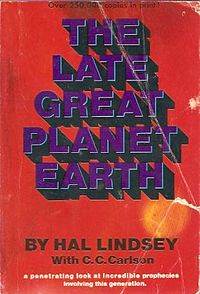
The Late, Great Planet Earth was the first Christian prophecy book to be picked up by a secular publisher (Bantam, 1973) and sold 28 million copies by 1990. I read this book during my first year at Northeastern University in 1974 and was deeply disturbed by it. The feelings were not related to the specifics but to a general feeling that from two thousand years ago biblical authors were already previewing trends that were already visible in the early 70s. The New York Times called it the “No. 1 non-fiction bestseller of the decade.” For Christians and non-Christians of the 1970s, Hal Lindsey’s blockbuster served as a wake-up call on events soon to come and events already unfolding.
The planet Earth may indeed be close to “late” simply because we have failed to face the real problems that confront us in a reasonable way. The book portrays much that has been true for decades, stories about famine, pollution and the destructive potential of our war machines, but the Japanese and the Americans, who built most of the Japanese nuclear industry, went over the top with MOX fuel, which is banned in most countries around the world that use nuclear power.
In 20 years it has become clear that not tens, hundreds or
thousands, but millions of people in the Northern hemisphere
have suffered and will suffer from the Chernobyl catastrophe.
Dr. Alexey V. Yablokov
Russian Academy of Sciences
More than a third of Britain is still contaminated by radioactivity from the Chernobyl disaster two decades ago, and children are getting cancer as a result. An investigation published in London on April 22, 2006, shows that at least 34% of the country will remain radioactive for centuries as the result of the accident. In Britain, about 81,000 sq km (31,000 sq miles)—mainly in Northern Ireland, Scotland, Wales and the west of England—were contaminated above 4,000 bequerels per square metre. The report says the radioactive caesium—and the doses of radiation it gives Britons—will only “decline slowly over the next few hundred years.”
One type of contamination reinforces and strengthens the other so medical treatments need to simultaneously address both chemical toxicity and radiation poisoning. Exposure to radiation causes a cascade of free radicals that wreak havoc on the body. Radiation also decimates the body’s supply of glutathione, thus allowing free radicals to run rampant through our tissues and organs.
The Chernobyl incident was a major humanitarian disaster resulting in a plethora of health problems that are still far from being fully recognized. Most studies analyzing the medical consequences of this catastrophe have so far focused on diseases such as thyroid cancer, leukemia, immune and autoimmune pathology[1],[2] even though an increase in the incidence of type 1 diabetes mellitus, a disorder involving the immune system, was observed within the residential population of Hiroshima among survivors of the atom bomb detonation.[3] Studies have also shown that thymectomy and a sub-lethal dose of gamma radiation induces type 1 diabetes in rats.[4]
Public health officials across the board tend to grossly underestimate the dangers[5] and medical officials are out there claiming, as usual, that toxic substances are actually good for your children. They say that about mercury and they say that about radiation.
Dr. Herman Muller, who has received a Nobel Prize for his work, has shown how the human race’s continuous exposure to so-called “low-level” radiation is causing a gradual reduction in its ability to survive, as successive generations are genetically damaged. “The spreading and accumulation of even tiny genetic mutations pass through family lines, provoking allergies, asthma, juvenile diabetes, hypertension, arthritis, high blood cholesterol conditions, and muscular and bone defects.”
Special Note—If you think there is nothing to worry about consider the fact that the cooling system for the spent fuel pool at the crippled Fukushima Daiichi power plant’s No. 4 reactor automatically shut down Saturday the 30th of June. Temperatures began to rise but fortunately, according to reports, they reestablished cooling on Sunday. I have written that humanity is hanging by a thread in terms of our vulnerability to building number four coming down. Radiation at the plant continues to increase so it is possible the day will arrive that no repairs can be made and the fuel pool will overheat to the point where it will all go up in flames.
[1] Kuzmenok O, Potapnev M, Potapova S et al. (2003) Late effects of the Chernobyl radiation accident on T-cell-mediated immunity in cleanup workers. Radiat Res 159: 109-116
[2] Lomat L, Galburt G, Quastel MR, Polyakov S, Okeanov A, Rozin S (1997) Incidence of childhood disease in Belarus associated with the Chernobyl accident. Environ Health Perspect [Suppl 105] 6:1529-1532
[3] Ito C (1994) Trends in the prevalence of diabetes mellitus among Hiroshima atomic bombsurvivors. Diabetes Res Clin Pract [Suppl]:S29-S35
[4] Ramanathan S, Bihoreau MT, Paterson AD, Marandi L, Gauguier D, Poussier P (2002) Thymectomy and radiation-induced type 1 diabetes in nonlymphopenic BB rats. Diabetes 51:2975-2981
[5] It could be possible, for instance, that a mere .001 rise in the rem could generate an increase globally in sickness. And the proximity of the source of rem increase may be less relevant than we think. Long-term exposure to >0.001 increased rem overall may be actually be quite profound. Our knowledge of the effects of radiation derives primarily from groups of people who have received high doses, so in reality medical science knows and understands very little about low-level risks.
